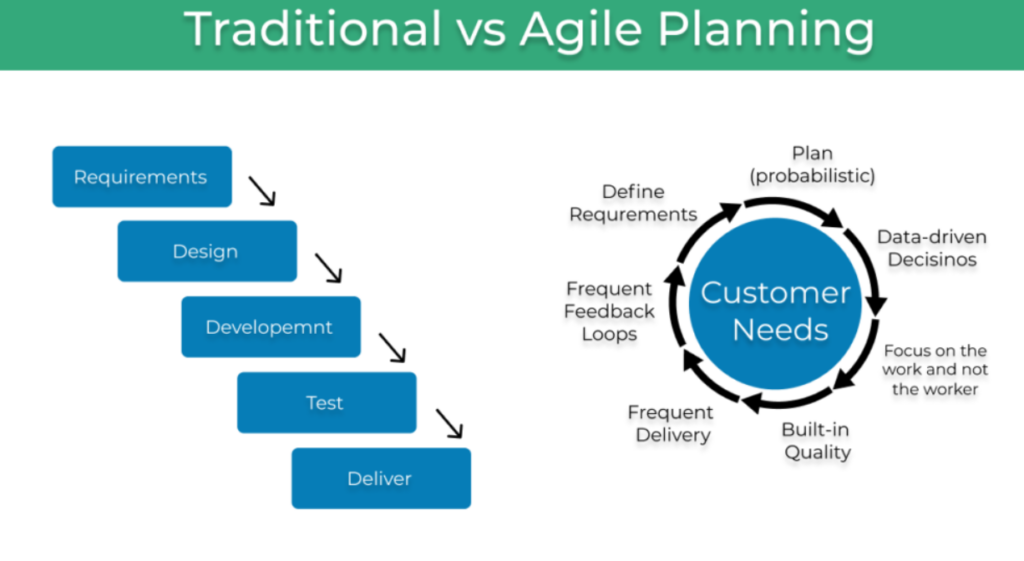
What is Agile Project Management?
Agile project management is an iterative approach to managing software development projects that focuses on continuous releases and incorporating customer feedback with every iteration. The methodology aims to deliver value to customers as early as possible, while remaining adaptable to changing customer needs and market trends. Agile project management is based on the values of trust, flexibility, empowerment, and collaboration. It breaks project processes down into smaller cycles, called iterations, to promote velocity and adaptability.
Agile vs. Waterfall
Traditional project management methodologies, such as the Waterfall approach, emphasize a linear, sequential process from start to finish. By contrast, agile project management is based on an incremental and iterative approach. While Waterfall focuses on big bang launches, agile helps software teams collaborate better and innovate faster than ever before by breaking the process down into smaller cycles. This allows teams to adjust as they go along, rather than being tied to a linear plan from the outset.

Agile Methodologies
Agile methodologies are a set of best practices and guidelines for implementing agile project management. Popular agile methodologies include Scrum, Kanban, Lean, and eXtreme Programming (XP). These methodologies help teams strike a healthy balance between structure and flexibility, allowing them to deliver value to customers quickly and efficiently.
The Scrum Framework
Scrum is a framework for agile project management that uses fixed-length iterations of work called sprints. There are four key events that bring structure to each sprint: the sprint planning meeting, the daily scrum meeting, the sprint review, and the sprint retrospective. The process starts with the backlog, a prioritized list of features owned by the product owner. The sprint backlog is then filled by taking issues from the top of the product backlog until the capacity for the next sprint is reached. The team planning meeting determines what to complete in the coming sprint, while the daily scrum meeting is a 15-minute mini-meeting for the team to sync. The sprint review is a sharing meeting where the team shows what they’ve shipped in that sprint, while the retrospective is a review of what did and didn’t go well, with actions to make the next sprint better. Scrum boards, which visualize all the work in a given sprint, are the key component for increasing transparency in agile project management.
The Kanban Framework
Kanban is a framework for agile project management that matches the work to the team’s capacity. It’s focused on getting things done as fast as possible, giving teams the ability to react to change even faster than Scrum. Work sits in the To Do column, and the amount of work is matched to the teams’ capacity through work in progress limits. The Kanban framework has four key components: a list of work, work in progress limits, a Kanban board, and a delivery cadence. The Kanban board is used to visualize all the work that’s being done, structured into columns and lanes that stories pass through on their way to completion. The list of work should be split into relatively small issues and organized by priority, and work in progress limits help ensure the team stays focused and on track.
Agile Metrics
Agile metrics are key performance indicators (KPIs) that help measure the success of an agile project management approach. Some popular agile metrics include sprint burn-down, epic and release burn-down, velocity control charts, and the cumulative flow diagram. By using these metrics, product owners can optimize for efficiency and impact.
Conclusion
Agile project management is a powerful tool for software development that can help teams work together more effectively, deliver value to customers quickly and efficiently, and adapt to changing requirements and market trends. By implementing best practices and guidelines from popular agile methodologies such as Scrum and Kanban, teams can strike a healthy balance between structure and flexibility, increasing predictability and control risk. With the right approach, agile project management can be a game-changer for your team, allowing you to innovate faster and deliver better results to your customers. [1][2]




